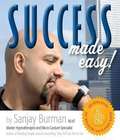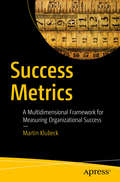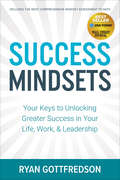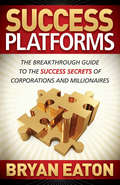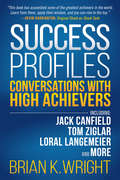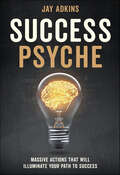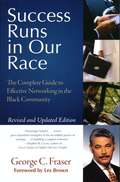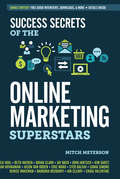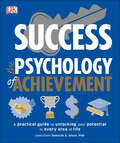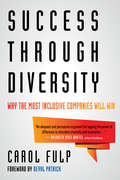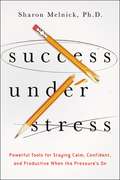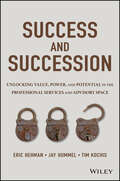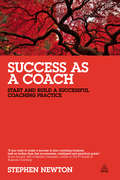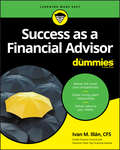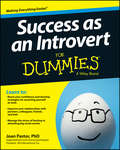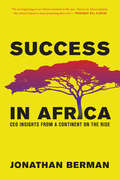- Table View
- List View
Success Made Easy
by Sanjay Burman8 Steps! 8 Exercises! 8 Weeks! A no-nonsense approach like never before! So what's your excuse? LIFE ISN'T HARD. We make it harder than it is. We can always find something to complain about! Yes, times are tough, but no tougher than before. It's our way of looking at things that have changed. Now I'm going to take you back to the basics. We are going to remove your fear of failure and even your fear of success! By the end of this audio book, if you dare to do all 8 exercises, I GUARANTEE that you will have far more success! This program has worked in many government organizations and corporations."
Success Metrics
by Martin KlubeckLearn how to measure success at the individual and organizational levels. By measuring success in multiple dimensions using multivariate methods you will be able to determine what works and what doesn't. The key is to measure and promote progress in terms of organizational vision, mission, and overarching goals. Business leaders too often succumb to the working assumption that they only have to show shareholders and boards of trustees that they are turning a profit--the higher the profit, the more successful their stewardship of the company. Wrong! To truly thrive and endure, all organizations--corporate, government, small, large, nonprofit, or startup--need to define and pursue the underlying purpose for their existence. To measure success, leaders today are missing a key meta-analytic in their toolbox. In this book, metrics consultant Martin Klubeck provides it to them. Success Metrics steps you through the process of identifying and combining the right measures to gauge, narrate, and guide your organization's progress toward true success. All organizations have a common goal to be successful. All leaders want to make data-informed decisions and use measures to improve processes, communicate progress, and gain support. The problem is that proxy or partial measures don't measure overall success and can be misleading. They measure performance parameters, progress on a specific task, customer feedback, and other piecemeal indices--which taken separately fail to describe an organization's progress toward overall success. The author's integrated measures of success can be used to communicate organizational progress to stakeholders, shareholders, boards of trustees, corporate leaders, the workforce, and the customer base and thereby galvanize broad commitment to organizational success. Klubeck shows how his principles and methods of measuring overall success can be applied at all levels: individual, team, group, department, division, and organization. What You Will Learn: Understand why you should measure success instead of performance Understand what to measure and what not to measure Integrate the measures of success to tell a complete story Share measures of success with different audiences Who This Book Is For Organizational leaders at all levels from the executive suite to middle management, analysts and consultants who are tasked with designing metrics programs for organizations, individuals interested in adapting the author's framework to measure overall personal success in multiple dimensions
Success Mindsets: Your Keys to Unlocking Greater Success in Your Life, Work, & Leadership
by Ryan GottfredsonSuccess Mindsets, written by Wall-Street Journal and USA Today Best-Seller Ryan Gottfredson, helps natural achievers, stalled professionals, and business executives unlock greater success in their life, work, and leadership. “Mindsets” is a word that is used quite frequently, however, many of those who use it are unaware that mindsets are foundational to and dictate one’s success in life, work, and leadership. They are also unable to identify specific mindsets that are necessary for success. Ryan Gottfredson has created a comprehensive and research-based guide, Success Mindsets, that is designed to awaken readers to:The power of mindsetsThe four mindsets they need to have to be successful The mindsets they currently possess through personal mindset assessment This awakening process empowers readers to unlock the greatness within themselves and reach the heights of success that they have been seeking but have thus far been unable to obtain. Within Success Mindsets, Ryan takes readers on a self-awakening journey to identify and unlock the four success mindsets necessary to enhance success across their life, work, and leadership.
Success Platforms: The Breakthrough Guide to the Success Secrets of Corporations and Millionaires
by Bryan EatonIn Success Platforms, author and certified project management professional (PMP), Bryan Eaton, details the twelve platforms that one must conquer to truly achieve success. With over 20 years of successful business experience with major U.S. firms in areas from broadcasting to healthcare, Eaton brings real world experiences into this holistic, integrated approach to achieving success. Having a successful platform is critical to the release of books, films and products. Yet, many ask “What is a platform?” Until now, there has been no definitive guide to building a successful platform. In an innovative perspective, Success Platforms expands the subject to include all the areas and tasks that are rarely brought into a single platform discussion. This insightful guide looks at each of the component platforms that combine to make that successful platform. Success Platforms"" breaks each area down to manageable components within each individual platform area. Individual exercises dig deeper into each subject and peel away the layers to acquire keen insights for achieving successful incremental steps to building your platform. As each platform is implemented, a synergy between the platforms organically combines to build your ""Success Platforms"". With humorous and relevant anecdotes, Eaton reveals the step-by-step means to bring successful change to anything. As with all great guides, the hazards that can be obstacles to success are exposed and countered. Success Platforms provides hands-on guidance to building the support systems that reduce risks and the unexpected in day to day success building. If you’ve ever wondered how success triumphs over failures to reach your goals, then this is your guidebook.
Success Principles for Leaders: 7 Steps on How to Lead with Love
by Gerald M. CzarneckiLearn How Excellence in Leading Equates to Succeeding. Come face to face with leadership reality and learn how to Lead with Love. Leadership guru, Gerry Czarnecki will provide you with realistic advice that you will be able to put into place today! Chapters are formatted for a quick read but will be a resource to you for years to come. Each chapter focuses on the 7 Lead with Love Principles in the L.E.A.D.E.R.S. mnemonic: Love–Expectations–Assignment–Development–Evaluation–Rewards–Self. Each chapter includes: Leadership Article, Mini Case Study, Leadership Tips & Techniques, "Ask Gerry" Q&A section. This book will teach you: The 7 Lead with Love principles, Leadership do's and don&’ts, Ideas on how to handle your most difficult employees, and Tips to help you identify & develop your employees into stars. This is the only leadership advice you will ever need as you Lead with Love.
Success Profiles: Conversations With High Achievers Including Jack Canfield, Tom Ziglar, Loral Langemeier and More
by Brian K. WrightSuccess Profiles: Conversations With High Achievers is a collection of the some of the greatest interviews that have occurred on the highly acclaimed Success Profiles Radio. Guests address topics such as success, leadership, building a successful business, financial excellence, and self-development, and include experts such as Jack Canfield, Tom ZIglar, Greg Reid, and many more. The leaders featured all had to overcome difficult obstacles on their way to financial success; they were nothing special when they started. This is a unique collection of wisdom from some of the greatest leaders in personal development and success today that shows readers how the success these leaders achieved is available to everyone and how to unlock their own journey to the top.
Success Psyche: Massive Actions That Will Illuminate Your Path to Success
by Jay AdkinsWhat motivates you to action? Is it seeing the success of others? Why do you want the things you want in life? How do you plan to get there?Success Psyche takes readers on a deep and personal dive into their own mind because for most people, they simply don’t know how. Maybe even worse, they don’t know why they set certain goals and never reach them. Each chapter is designed to represent one of the 12 massive actions that are necessary for success in any industry and for anyone. The time for excuses is over, and the time for measurable and attainable action is now. Success Psyche provides readers with the GPS they need to set their intention each and every day and actually reach it. People already have everything inside that it takes to achieve their definition of greatness. It’s time to realize the potential and take action!
Success Runs in Our Race
by George C. FraserA completely updated and revised edition of a bestselling book that has helped tens of thousands of people learn how to network effectively, Success Runs in Our Race is more important than ever in this fluctuating economy. With scores of anecdotes taken from interviews with successful African Americans -- from Keith Clinkscales, founder and former CEO of Vanguarde Media, to Oprah Winfrey -- Fraser shows how to network for information, for influence, and for resources. Readers will learn, among other things, how to cultivate valuable listening skills, which conferences blacks are most likely to attend when looking to build their business network, and how to effectively circulate a rÉsumÉ. More than a guide for personal achievement, this is an information-packed bible of networking that also seeks to inspire a social movement and a rebirth of the "Underground Railroad," in which successful African Americans share the lessons of self-determination and empowerment with those still struggling to scale the ladder of success.
Success Secrets of Sales Superstars
by Robert L. Shook Barry FarberShook and Farber invite eager entrepreneurs to join 33 of today's business and sales best as they share the details behind their greatest sales moves and ultimately, impart valuable lessons on how to sell your way to success.Crafted to cover a variety of industries, products, and services, this entertaining playbook urges entrepreneurs to reinvent their sales approach, illustrating proven techniques, tips, and tricks in each story and summarizing the unique take-away offered by its teller. Entrepreneurs uncover such pearls as how to ignite creativity to overcome sale barriers, how to create long-term customers, and how to sell what the customer wants (hint: it's not always a product or service). Entrepreneurs also gain invaluable insight and encouragement as they turn from story to story, leaving the pages with lessons learned and the excitement of being privy to an exchange among the elite in their industry.
Success Secrets of the Online Marketing Superstars
by Mitch MeyersonEager business owners gain access to the playbooks of 23 of today's most respected and well-known online marketers, who reveal their most valuable online strategies and tactics for capturing new customers and influencing ongoing purchases from current ones. Each chapter is a coaching session designed to help business owners avoid the pitfalls and mistakes by the experts who have been there and done that. Readers learn how to develop a personal media brand, build a total online presence, and create a social media strategy that increases traffic. They also discover how to develop and use content that converts visitors into buyers and ultimately loyal customers, succeed with SEO, pay-per-click, and linking strategies that get websites ranked. Also included is information on leveraging social networking apps, including Facebook, online video, and Instagram, and avoiding the mistakes made by new online businesses.
Success Secrets of the Social Media Marketing Superstars
by Mitch MeyersonOnline marketing expert Mitch Meyerson presents you with an unmatched advantage into the world of social media - the priceless secrets, strategies, tactics and insights of more than 20 of today's social media elite. Handpicked to cover almost every aspect of social media marketing, Meyerson and this distinguished team of experts open their playbooks and teach you how to create effective social media campaigns to cut through the clutter, reach out to millions and grow your business. Features: Proven tips and tactics from 20+ top social media marketers The biggest mistakes businesses make with social media and how to fix them Actionable plans for all areas including social networks, blogs, web TV and mobile marketing Real-world case studies, best practices and proven techniques from the experts Detailed list of resources
Success The Psychology of Achievement: A Practical Guide to Unlocking You Potential in Every Area of Life
by DKSuccess: The Psychology of Achievement is a dynamic infographic guide that equips you with the tools you need to drive yourself toward success, whether you are seeking improvement in your career, relationships, or in your overall performance.Give your confidence a boost, master your resources, and raise your self-awareness with proven psychological strategies and expert advice. From positive thinking to work-life balance to learning how to say no, the lessons learned from this guide are tailored to your personal situation through questionnaires and self-analysis exercises. Infographic illustrations and diagrams make the information comprehensible, and quick, practical pointers enable you to apply techniques immediately.Grounded in scientific study, psychological expertise, and practical advice, Success: The Psychology of Achievement can help you improve your effectiveness and transform your future.
Success Through Diversity: Why the Most Inclusive Companies Will Win
by Deval Patrick Carol FulpExplores how investing in a racially and ethnically diverse workforce will help make contemporary businesses more dynamic, powerful, and profitableIn our fast-changing demographic landscape, companies that proactively embrace diversity in all areas of their operations will be best poised to thrive. Renowned business leader and visionary Carol Fulp explores staffing trends in the US and provides a blueprint for what businesses must do to maintain their competitiveness and customer base, including hiring in new ways, aligning managers around diversity, providing new kinds of leadership development, and engaging employees to embrace differences. Using detailed case histories of corporate cultures such as the NFL, Eastern Bank, John Hancock, Hallmark Health, and PepsiCo, as well as her own experiences in the workplace and in advising companies on diversity practice, Fulp demonstrates how people of different races and ethnicities represent an essential asset to contemporary companies and organizations.
Success Under Stress: Powerful Tools for Staying Calm, Confident, and Productive When the Pressure's On
by Sharon MelnickFrom overflowing priority lists to power-hungry colleagues to nagging parental guilt, stress is the defining characteristic of most of our lives. Real help is here an all-encompassing, stress-busting tool kit that goes far beyond breathing exercises and visualization techniques. Such one-size-fits-all methods are no match for the stressors we experience daily in our overcomplicated lives. Whether you have too many projects, your confidence is flagging, or you are clashing with a coworker, Success Under Stress provides a flexible array of strategies. You will learn how to: Adjust your perspective to see opportunity instead of obstacles Alter your physiology to get focused when overwhelmed, energized when exhausted, and calm when wired Change the problem to prevent the stress from returning All in all, Success Under Stress offers a veritable arsenal of magic bullet solutions hundreds of situation-specific, quick-acting tips for defusing stress and boosting roductivity. Complete with quizzes, examples, exercises, and more, this practical book helps you gain control, exude calmness and confidence amidst everyday chaos, and achieve the success you richly deserve.
Success and Failure of IS/IT Projects
by Yogesh K. Dwivedi D. Laurie Hughes Antonis C. Simintiras Nripendra P. RanaThis book examines the link between change and project management and how creating a closer alignment between these two methodologies can yield greater benefits and mitigate elements of failure of information systems (IS) projects. This study explores the underlying challenges and practicalities of closer integration of the two disciplines and asserts that such a successful change goes beyond the simple training of project managers in the practitioner context. Instead, it requires organizations to conceptualize the necessary challenges to realize the potential benefits of this recommended integrated approach. The integration of both project and change management has been advocated in existing research, but the challenges of moving from a current position of separate methodologies, different standards bodies and in some cases totally separate organizational structures, is a step change for many organizations. Change initiatives where good change management practices are implemented, can increase the probability of successful organizational change. The tasks of leading and sustaining change can be complex and often entail the interplay of multiple factors involving action by people at every level of the business. This book offers a guide that identifies the barriers and major challenges that may arise in the development of the closer integration of change and project management. With a better understanding of these issues, organizations can avoid such pitfalls when establishing their own integrated approach.
Success and Luck: Good Fortune and the Myth of Meritocracy
by Robert H. FrankHow important is luck in economic success? No question more reliably divides conservatives from liberals. As conservatives correctly observe, people who amass great fortunes are almost always talented and hardworking. But liberals are also correct to note that countless others have those same qualities yet never earn much. In recent years, social scientists have discovered that chance plays a much larger role in important life outcomes than most people imagine. In Success and Luck, bestselling author and New York Times economics columnist Robert Frank explores the surprising implications of those findings to show why the rich underestimate the importance of luck in success--and why that hurts everyone, even the wealthy.Frank describes how, in a world increasingly dominated by winner-take-all markets, chance opportunities and trivial initial advantages often translate into much larger ones--and enormous income differences--over time; how false beliefs about luck persist, despite compelling evidence against them; and how myths about personal success and luck shape individual and political choices in harmful ways.But, Frank argues, we could decrease the inequality driven by sheer luck by adopting simple, unintrusive policies that would free up trillions of dollars each year--more than enough to fix our crumbling infrastructure, expand healthcare coverage, fight global warming, and reduce poverty, all without requiring painful sacrifices from anyone. If this sounds implausible, you'll be surprised to discover that the solution requires only a few, noncontroversial steps.Compellingly readable, Success and Luck shows how a more accurate understanding of the role of chance in life could lead to better, richer, and fairer economies and societies.
Success and Succession
by Eric Hehman Jay Hummel Tim KochisAn insightful look at leadership transition from the successor's perspective Success and Succession examines the leadership transition process from the successor's point of view, and outlines the considerations and strategies that lead to a better future for the business. With a focus on practical planning and execution, this insightful guide provides insight into the strategies that smooth the transition and help the new leadership make better business decisions. You'll learn when and how to start planning, who you need on your team, and the obstacles you should anticipate along the way. You'll learn to navigate the uncertainty the process entails, and how to identify opportunities for reciprocal understanding and adopt workable approaches for successful resolution of a multitude of transition issues. Interviews with those at various stages of transition highlight the real-world application of these ideas, and give you an inside look at what worked, what didn't, and what they wish they had thought of. The transition of leadership in an independent, non-public professional service business can be emotional and difficult for everyone. This book gives you a framework for smoothing the process and driving the best possible future of the business. Consider the complexities of succession and transition Balance conflicting dynamics of outgoing and incoming leadership Plan for operational, financial, and emotional obstacles Develop and execute a winning strategy for long term success The transition from founder to successor is far from an academic exercise, and is not linear. Answers are hard to find, and the ebb and flow of the process requires patience, creativity, and willingness to try again. Success and Succession provides a unique strategy for success, from the perspective of incoming leadership.
Success as a Coach
by Stephen NewtonWhat does it take to be a successful coach? Assuming that you already possess the right skills, characteristics and training then success simply lies in finding and winning clients that you can coach successfully. Personal fulfilment and profitable fee revenue will be direct results. Unfortunately this isn't as simple as it might seem. Success as a Coach is your complete guide to business development whether you're newly qualified or an experienced coach. It covers all the crucial factors that will help you build your clients and your business including: finding the right clients; extending your professional network; planning and running meetings; delivering value for the client; calculating fees; structuring and delivering sessions; structuring your business; strategic client leadership and systematically growing your business.Additional downloadable tools and templates will be available from www.successasacoach.com on publication.
Success as a Financial Advisor For Dummies
by Ivan M. IllanA must-have reference for financial advisors In step-by-step detail, Success as a Financial Advisor For Dummies covers how a current or would-be financial advisor can maximize their professional success through a series of behaviors, activities, and specific client-centric value propositions. In a time when federal regulators are changing the landscape on the standard of care that financial services clients should expect from their advisors, this book affords professionals insight on how they can be evolving their practices to align with the regulatory and technological trends currently underway. Inside, you’ll find out how a financial advisor can be a true fiduciary, how to compete against the growing field of robo-advisors, and how the passive investing trend is actually all about being an active investor. Additionally, you’ll discover time-tested advice on building and focusing on client relationships, having a top advisor mindset, and much more. Master the seven core competencies Attract and win new business Pick the right clients Benchmark your performance Start your own firm Brimming with practical expert advice, Success as a Financial Advisor For Dummies is a priceless success tool for any wannabe or experienced financial advisor.
Success as a Real Estate Agent For Dummies
by Dirk ZellerMake your fortune in the real estate business? Easy.Whether you are looking to rev up your real estate business, deciding whether to specialize in commercial or residential real estate, or just interested in refining specific skills, Success as a Real Estate Agent For Dummies has it covered.This no-nonsense guide, with guidance from an industry expert, shows how you can become a successful real estate agent. It provides advice on acquiring the skills needed to excel and the respect and recognition you'll gain through making sales and generating profit. Soon you'll have all the tools you need to: prospect your way to listing and sales; build a referral-based clientele; plan and host a successful open house; present and close listing contracts; stake your competitive advantage; spend less time to earn more money; and much more.Features tips and tricks for working with buyersIncludes must-haves for a successful real estate agentsOffers tried-and-true tactics and fresh ideas for finding more prospects--and closing more dealsWhether it's lead generation via blogging or social media channels, Success as a Real Estate Agent For Dummies gives you key ways to communicate and prospect in a new online world.
Success as a Real Estate Agent For Dummies
by Dirk ZellerStraight-talking advice for new and veteran agents navigating today's real estate market Success as a Real Estate Agent For Dummies helps you create leads, close deals and everything in between. This updated edition covers changes to interest rates, inventory, and the impact of recent class action lawsuits on agent compensations. With tried-and-true tactics and fresh ideas from one of North America's top agents, this book contains all you need to know about the real estate business. Inside, you'll find tips and tricks on selecting a company that works best for you and your goals, marketing yourself and your listings with influence, and communicating effectively with clients. The actionable content in this Dummies guide is your ticket to thriving in a wide market. Gain insider advice on how to flourish as an agent in all real estate markets Understand how real estate is changing, and what those changes mean for you Find, secure, and sell more properties with optimized listings and outreach Get fresh ideas for improving your results in residential and commercial sales For new licensed real estate agents, those switching careers into real estate agenting, or seasoned agents looking to refine their prospecting and selling skills, this book is a valuable source of information and techniques.
Success as a Real Estate Agent for Dummies - Australia / NZ (For Dummies Ser.)
by Dirk Zeller Terri M. CooperYour no-nonsense guide to becoming a successful real estate agent in the Australian and New Zealand markets As the Australian and New Zealand housing markets begin to recover, now is the time to make the jump to your new career as a real estate agent. If you're already an agent, it's a great time to sharpen your skills and increase your commissions. Success as a Real Estate Agent For Dummies provides the foundation and advice you need to become a real estate superstar. Written specifically for agents and potential agents in Australia and New Zealand, this handy, plain-English guide gives you all the tools you need to bring in new prospects, close sales, build a referral base, plan open houses, present and close listing contracts, and give yourself a leg up on the competition. Whether you want to get involved in commercial or residential real estate, you'll find all the guidance you need to do it right. Includes handy tips and tricks for working with buyers Offers practical advice on prospecting and generating leads online, including how to use social media Presents tried-and-true tactics and fresh ideas for closing deals Whether you're looking to get started in real estate, or you're a working agent who wants to up your game, Success as a Real Estate Agent For Dummies gives you the tools and insight you need to compete—and succeed.
Success as an Introvert For Dummies
by Joan PastorThrive as an introvert in an extrovert worldBill Gates, Mark Zuckerberg, and author J.K. Rowling have more in common than being highly successful. They're also introverts. Success as an Introvert For Dummies identifies common misunderstandings about introverts and highlights the strengths often found in people associated with this worldview.Success as an Introvert For Dummies examines the traits common to introverts and the benefits they bring to both work and life. You'll learn: how to boost your confidence while learning strategies for successfully living in an extrovert world; how to understand introversion and where you fall on the introvert/extrovert continuum; tools to improve relationships with colleagues, partners, friends, and children; ways to talk less, communicate more, and showcase your abilities at work; how to deal effectively with parties, interruptions, and crowds; and much more.Offers examples of how introverts can thrive in a world dominated by extrovertsOutlines the positive aspects of introverted personality typesProvides actionable ways to promote introverted qualities in work and lifeSuccess as an Introvert For Dummies is for anyone looking to understand the introvert's worldview and how they fit into a society dominated by extroverts.
Success from the Inside Out: Power to Rise from the Past to a Fulfilling Future
by Nona JonesIn Success from the Inside Out, corporate executive and leadership speaker Nona Jones takes you on a personal journey to discovering the difference between success that empties, and success that fills. Many of us aspire to achieve position, wealth, and notability in the hopes that those things will erase the pain of the past. But for those like Nona Jones who have experienced trauma, success requires more than a changed mindset--it requires repairing a broken spirit.Nona was appointed to an executive role with a Fortune 100 company at only 23 years old. Since then, she has led award-winning initiatives in public affairs, brokered multi-million dollar business deals, addressed the United Nations, and championed juvenile justice and education policy reform in the halls of Congress--all under the age of 35.Then in one of the largest wake-up moments of her life, Nona realized that her past battles were waging a present war. Though she tried to push away the memories, her childhood trauma continued to affect her emotionally, spiritually, mentally, and physically--until she made a pivotal decision.Success from the Inside Out charts the course of Nona's breakthrough--a course that can also lead you out of the storms of your past or present. Through her own remarkable story and insights, Nona helps you:Claim victory at the place where the defeat happenedRecognize ways you use work to cover up inward brokennessStill the voices in your head that say you aren't good enoughChoose not just empty success but fulfilling successMap your mile-markers toward your biggest goalsPush through from brokenness to breakthroughAs Nona writes, "I've discovered that the only thing stronger than the power trauma has to change you is the power you reclaim when you acknowledge its effect on you." Success from the Inside Out is an empowering guide to finding healing from the past so you can move with freedom and hope into the future.
Success in Africa: CEO Insights from a Continent on the Rise
by Robert Rubin Jonathan BermanIn an era of slowing growth, Africa is home to a trillion-dollar, resource-rich economy, and six of the ten fastest growing markets in the world. Success in Africa introduces the ambitious CEOs who are building the continent. These stories of growth, technology, and tradition bring life to one of the most important stories of the global economy: a successful Africa.The CEOs of General Electric, The Coca Cola Company, and Tullow Oil join Africa's leading CEOs to share insights on what wins in this fast-growth market. With twenty years of experience in frontier markets, including a decade working in Africa, author Jonathan Berman engages with top business leaders on the vast opportunities and challenges of the continent. Success in Africa pushes past the headlines on Africa's growth to answer the questions often asked by companies and investors: Who do I work with there and what drives them? How do I deal with government? What about war, disease, and poverty? What about China? How do I win?Success in Africa provides on-the-ground perspective, personal stories, and insight that Robert Rubin calls essential reading for all who are interested in Africa for reasons of business, investment, policy, or curiosity.
